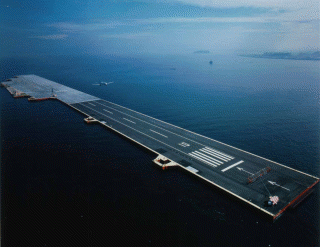What is Mega-Float?
Mega-Float is a Very Large Floating Structure (VLFS) with potential long-term durability for use in sea areas. It’s several units, which are constructed from iron and steel products are welded together offshore. Through the construction of facilities on its artificial landbase, Mega-Float promotes the extensive use of our ocean spaces.
Mega-Float is characterized by features that include being unaffected by earthquake, having few environmental impacts on ocean currents and marine eco-systems, being able to be constructed at low cost and in a short period of time independent of ocean depth and ground condition, and also earmarking the possible use of its immense internal spaces. Furthermore, Mega- Float is expected to supplement current construction technology on land filling and other construction as a new technology that can be applied to many fields.
-
Feasibility Studies on Mega-Float Airports
Mega-Float was a focus of constant attention in regards to the feasibility of housing airport facilities on its foundations, particularly for metropolitan cities that typically require large airports, but only have limited construction space.
In 1997 the “Mega-Float Airport Investigation Committee” (Koichiro Yoshida, Professor of Tokai University as Chairman) was set up within the Ministry of Land, Infrastructure and Transport (at that time the former Ministry of Transport) to investigate the technical aspects of using Mega-Float as a floating airport. As a result, fifteen areas requiring further investigation were identified as follows. An interim report compiled by the committee suggested that the Mega-Float was available for airport, should those fifteen technological issues be overcome. The Main Areas of Required Investigation;
-Research into the potential design of a large-scale Mega-Float airport that accounts for hydro-elastic response.
-Research into whether minute motions due to hydro-elastic response in the floating airport would affect “Instrument Landing System” (ILS) and “Precision Approach Path Indicators” (PAPI).
-Experiments into whether safe take-offs and landings can actually be made under minute motions due to hydro-elastic response in the floating airport.
-Research into the environmental impact on marine eco-systems from the undersea noise caused by the take-off and landing of aircraft.
-
Research and Development on Mega-Float Airports
Consequently, based on the outcomes of the three years research and development for Mega-Float construction carried out up until 1997, research and development on the feasibility of the Mega-Float airport was started in 1998, through the cooperation of seventeen of Japan’s top shipbuilding and steel-making enterprises. In the year of 2000, an actual Mega-Float airport, with dimensions of 1000m in length and 121m in width (and also a narrower section of 60m), was constructed in Tokyo Bay, in order to undertake verification experiments.
Subsequently, actual take-offs and landings were conducted and the research outcomes required to overcome the above areas were obtained as follows. -
The Main Outcomes of the Research and development;
-A number of programs were developed to design a large-scale Mega-Float airport taking into account of hydro-elastic response. Using these programs, test designs of an approximately 5000m long floating airport containing a 4000m-class runway were drafted.
-Programs were developed to estimate fluctuations in the radio wave of ILS and PAPI, which are caused by the minute motions due to hydro-elastic response in the Mega-Float airport. These were then analyzed using the 4000m-class test designs. In addition, through the inputting of the analyzed values into a Japan Airlines’ flight simulator, several active pilots made simulated landings at the Mega-Float airport for evaluation. The results of these evaluations indicated the hydro-elastic response have absolutely no affect on landing.
-Actual test take-offs and landings carried out on the 1000m Mega-Float in Tokyo Bay enabled various data to be collected and analyzed, but no noticeable difference to airports on land was recorded. Furthermore, the results proved to be even more successful when the pilots who participated in the take-off and landing verification tests also evaluated the Mega-Float runway as being no different to any other airport.
-The environmental impact of the undersea noise caused by the take-off and landing of aircraft was evaluated to be at a level that would not affect the habitat of marine life.
| In March of 2001, the “Mega-float Airport Investigation Committee” put together a detailed evaluation of the verification tests on the 1000m Mega-Float airport and the 4000m-class test design, and announced in their final report that a Mega-Float airport with a scale of up to 4000m as being more than feasible. |
Any inquiries on the Mega-float airport can be directed to;
|
 |
|||
|
1000m Mega-Float floating airport model in Tokyo Bay |
![]()
All Rights Reserved, Copyright (C) 2001, Ministry of Land, Infrastructure and Transport
